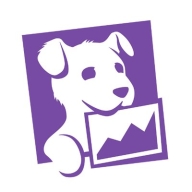

Datadog and AWS X-Ray are prominent contenders in the application performance monitoring market. Datadog holds a slight edge due to its extensive third-party integrations and customizable dashboards.
Features: Datadog features robust integrations with ServiceNow and PagerDuty, personalized dashboards, and detailed logging capabilities enhancing issue response and mitigating downtime. AWS X-Ray provides clear trace metrics and real-time insights, enabling effective service flow understanding and data correlation across services within AWS environments.
Room for Improvement: Datadog's flexibility can impact user-friendliness; users desire better documentation and service management tools, alongside more training resources and cost management capabilities. AWS X-Ray requires improvements in its user interface and setup process, with users requesting expanded support for AWS services.
Ease of Deployment and Customer Service: Datadog offers flexible deployment models across on-premises, hybrid, and public cloud environments, with responsive customer service, though support quality varies. AWS X-Ray is straightforward in AWS setups but noted for setup complexity, primarily in public cloud environments.
Pricing and ROI: Datadog's pricing is complex, particularly for logs and APM, demanding careful cost management despite recognized efficiency and reliability values. AWS X-Ray is generally cost-efficient within AWS settings but can be pricey at scale. Both offer strong ROI though Datadog requires a more meticulous approach to feature cost management.
| Product | Market Share (%) |
|---|---|
| Datadog | 5.5% |
| AWS X-Ray | 2.0% |
| Other | 92.5% |


| Company Size | Count |
|---|---|
| Small Business | 8 |
| Large Enterprise | 3 |
| Company Size | Count |
|---|---|
| Small Business | 80 |
| Midsize Enterprise | 46 |
| Large Enterprise | 98 |
AWS X-Ray is a powerful debugging and performance analysis tool offered by Amazon Web Services. It allows developers to trace requests made to their applications and identify bottlenecks and issues.
With X-Ray, developers can visualize the entire request flow and pinpoint the exact location where errors occur. It provides detailed insights into the performance of individual components and helps optimize the overall application performance.
X-Ray integrates seamlessly with other AWS services, making it easy to trace requests across different services and identify dependencies. It also offers a comprehensive set of APIs and SDKs, enabling developers to instrument their applications and capture valuable data for analysis. With its user-friendly interface and powerful features, AWS X-Ray is a valuable tool for developers looking to improve the performance and reliability of their applications.
Datadog integrates extensive monitoring solutions with features like customizable dashboards and real-time alerting, supporting efficient system management. Its seamless integration capabilities with tools like AWS and Slack make it a critical part of cloud infrastructure monitoring.
Datadog offers centralized logging and monitoring, making troubleshooting fast and efficient. It facilitates performance tracking in cloud environments such as AWS and Azure, utilizing tools like EC2 and APM for service management. Custom metrics and alerts improve the ability to respond to issues swiftly, while real-time tools enhance system responsiveness. However, users express the need for improved query performance, a more intuitive UI, and increased integration capabilities. Concerns about the pricing model's complexity have led to calls for greater transparency and control, and additional advanced customization options are sought. Datadog's implementation requires attention to these aspects, with enhanced documentation and onboarding recommended to reduce the learning curve.
What are Datadog's Key Features?In industries like finance and technology, Datadog is implemented for its monitoring capabilities across cloud architectures. Its ability to aggregate logs and provide a unified view enhances reliability in environments demanding high performance. By leveraging real-time insights and integration with platforms like AWS and Azure, organizations in these sectors efficiently manage their cloud infrastructures, ensuring optimal performance and proactive issue resolution.
We monitor all Application Performance Monitoring (APM) and Observability reviews to prevent fraudulent reviews and keep review quality high. We do not post reviews by company employees or direct competitors. We validate each review for authenticity via cross-reference with LinkedIn, and personal follow-up with the reviewer when necessary.